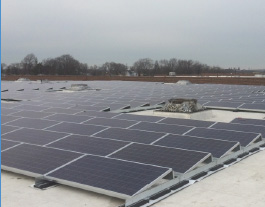 Commercial Industrial Solar Energy is a great solution for many businesses. Many are taking advantage of commercial industrial solar energy however, there are some issues to be considered.
Commercial Industrial Solar Energy is a great solution for many businesses. Many are taking advantage of commercial industrial solar energy however, there are some issues to be considered.
Download Full Printable Article (PDF) >>
Thousands of commercial and industrial business owners have already installed solar energy and are enjoying the benefits of free energy from the sun, but that doesn’t mean solar is an easy solution for every building. There may be challenges inherent in the rent roll of tenants, or even in the physical structure of the building itself.
Below, we summarize the top five challenges to commercial solar projects that we see most often. In most cases, these challenges can be overcome – either by aligning landlord and tenant incentives, designing creative engineering solutions, or structuring financing and tax incentives.
Commercial Industrial Solar Energy Challenges
1. LANDLORD-TENANT ALIGNMENT
While not a problem for owner-occupied buildings, issues sometimes arise with landlord-owned properties. For example, a landlord might be interested in commercial industrial solar energy, but their tenant controls the electric meter in their name and pays directly for electricity. The landlord has little incentive to invest in a benefit accruing only to the tenant. A solution would be for the landlord to own the solar and sell the electricity back to the tenant. But, even this structure could be risky, if the tenant’s lease expires within the next 1-3 years. Conversely, a tenant on a decades-long lease may prefer to own the solar panels outright, but the landlord may not see the benefit, or has concerns about installing solar on their roof. In other cases, a flex building might be ideal for solar energy, but the building has dozens of tenants, each with their own electric meter and various lease terms/ expirations. In each of these scenarios, creative structures can allow for solar and produce incremental benefits for both landlord and tenants.
2. ELECTRICAL LOAD
Many industrial buildings have large rooftops capable of accommodating extensive solar energy installations. In general, however, commercial industrial solar energy is limited in sizing to offset the annual electric bill on the metered account within the building. Large industrial buildings often serve as warehouses without the electric bills that accompany heating, cooling and industrial processing, thus capping the size of a potential solar installation. To leverage solar energy, it might make sense to convert gas or propane equipment to electrical equipment. In other cases, it may be worthwhile to fill a large rooftop with solar panels and re-direct the electricity not to the building, but directly onto the grid.
3. ROOF AGE
Solar panels are warranted for 25 years and last 30-40 years. This timeline may present problems if not aligned with the age of the underlying roof. If solar panels are installed and the roof then needs to be replaced, the building will incur incremental expenses to remove the solar panels, replace the roof and then re-install the solar. For any roof less than 5 years old, the remaining lifetime of the roof lines up perfectly with the lifetime of the solar installation, so this is not a problem. Conversely, for any roof 15-25 years old, it can be more cost-effective to replace the roof in conjunction with a solar
panel installation. In some cases, it may make sense to accelerate a planned roof replacement by a few years in order to undertake a solar installation sooner. When installing solar on a roof, it is critical that your solar installer and roofer work together to integrate the two systems.
4. STRUCTURAL
On the East Coast, rooftop solar is mostly secured by ballast and not attached to the roof with penetrations. Solar panels will add some additional weight on a building – generally 3-6 psf. Many buildings are built to withstand this additional weight, however it is critical that a qualified structural engineer inspect a building to determine its structural capacity. Many pre-fabricated “Butler-style” buildings were not built with much incremental capacity and should be carefully analyzed. Solar can be engineered to minimize its weight and work within the constraints of the building.
5. CAPITAL
Business owners have many competing uses for their capital, and there are always internal needs of the core business – both operating and growth. Solar can offer returns that exceed investments in core operations, but solar is still considered a “nice to have” rather than a “must have.” To address this issue, the solar industry has created financing structures that are recourse to the solar project only. These structures are non-recourse to a company or its balance sheet and have no impact on a company’s ability to borrow or use funds for core operations. In many cases, lenders prefer a solar investment because it is less risky than core operations and it improves the financial stability of their borrowers. A good solar installer should not steer you to their preferred financing structure, but rather help you explore the many solar financing options available to your company.
 Keith Peltzman
Keith Peltzman
President & Founder
1008 Astoria Boulevard
Suite E
Cherry Hill, NJ 08003
856.393.1250
ABOUT US
 Keith Peltzman is president and founder of Independence Solar with offices in Cherry Hill, NJ and Boston, MA.
Keith Peltzman is president and founder of Independence Solar with offices in Cherry Hill, NJ and Boston, MA.
Independence Solar is a turnkey installer of commercial solar energy. Since 2007, the team has developed and built over $200 million of solar projects, including the largest rooftop solar array (9 MW) in North America at the Gloucester Marine Terminal in NJ. Independence Solar forges long-term partnerships to maximize returns on our customers’ solar energy investments.


